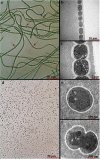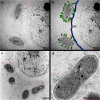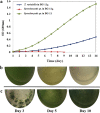Decoupling a novel Trichormus variabilis-Synechocystis sp. interaction to boost phycoremediation
- PMID: 30792472
- PMCID: PMC6385349
- DOI: 10.1038/s41598-019-38997-7
Decoupling a novel Trichormus variabilis-Synechocystis sp. interaction to boost phycoremediation
Abstract
To conserve freshwater resources, domestic and industrial wastewater is recycled. Algal systems have emerged as an efficient, low-cost option for treatment (phycoremediation) of nutrient-rich wastewater and environmental protection. However, industrial wastewater may contain growth inhibitory compounds precluding algal use in phycoremediation. Therefore, extremophyte strains, which thrive in hostile environments, are sought-after. Here, we isolated such an alga - a strain of Synechocystis sp. we found to be capable of switching from commensal exploitation of the nitrogen-fixing Trichormus variabilis, for survival in nitrogen-deficient environments, to free-living growth in nitrate abundance. In nitrogen depletion, the cells are tethered to polysaccharide capsules of T. variabilis using nanotubular structures, presumably for nitrate acquisition. The composite culture failed to establish in industrial/domestic waste effluent. However, gradual exposure to increasing wastewater strength over time untethered Synechocystis cells and killed off T. variabilis. This switched the culture to a stress-acclimated monoculture of Synechocystis sp., which rapidly grew and flourished in wastewater, with ammonium and phosphate removal efficiencies of 99.4% and 97.5%, respectively. Therefore, this strain of Synechocystis sp. shows great promise for use in phycoremediation, with potential to rapidly generate biomass that can find use as a green feedstock for valuable bio-products in industrial applications.
Conflict of interest statement
The authors declare no competing interests.
Figures




Similar articles
-
Extraction of hydrocarbons from freshwater green microalgae (Botryococcus sp.) biomass after phycoremediation of domestic wastewater.Int J Phytoremediation. 2017 Jul 3;19(7):679-685. doi: 10.1080/15226514.2017.1284743. Int J Phytoremediation. 2017. PMID: 28121457
-
Mixotrophy in Synechocystis sp. for the treatment of wastewater with high nutrient content: effect of CO2 and light.Bioprocess Biosyst Eng. 2019 Oct;42(10):1661-1669. doi: 10.1007/s00449-019-02162-1. Epub 2019 Jun 22. Bioprocess Biosyst Eng. 2019. PMID: 31230131
-
Experimental and kinetic studies for phycoremediation and dye removal by Chlorella pyrenoidosa from textile wastewater.J Environ Manage. 2015 Nov 1;163:270-7. doi: 10.1016/j.jenvman.2015.08.041. Epub 2015 Sep 5. J Environ Manage. 2015. PMID: 26349408
-
Phycoremediation of nitrogen and phosphate from wastewater using Picochlorum sp.: A tenable approach.J Basic Microbiol. 2022 Mar;62(3-4):279-295. doi: 10.1002/jobm.202100277. Epub 2021 Jul 26. J Basic Microbiol. 2022. PMID: 34312905 Review.
-
The potential of sustainable algal biofuel production using wastewater resources.Bioresour Technol. 2011 Jan;102(1):17-25. doi: 10.1016/j.biortech.2010.06.035. Epub 2010 Jul 1. Bioresour Technol. 2011. PMID: 20594826 Review.
Cited by
-
Sustainable Production of Microbial Isoprenoid Derived Advanced Biojet Fuels Using Different Generation Feedstocks: A Review.Front Bioeng Biotechnol. 2020 Oct 30;8:599560. doi: 10.3389/fbioe.2020.599560. eCollection 2020. Front Bioeng Biotechnol. 2020. PMID: 33195174 Free PMC article. Review.
-
Biosynthesis Progress of High-Energy-Density Liquid Fuels Derived from Terpenes.Microorganisms. 2024 Mar 30;12(4):706. doi: 10.3390/microorganisms12040706. Microorganisms. 2024. PMID: 38674649 Free PMC article. Review.
-
Algae as a green technology for heavy metals removal from various wastewater.World J Microbiol Biotechnol. 2019 May 3;35(5):75. doi: 10.1007/s11274-019-2648-3. World J Microbiol Biotechnol. 2019. PMID: 31053951 Review.
-
Cost-effective tannery wastewater treatment using cyanobacteria: insights on the growth pattern and seedling vigor improvement with spent biomass.3 Biotech. 2023 Sep;13(9):295. doi: 10.1007/s13205-023-03712-x. Epub 2023 Aug 8. 3 Biotech. 2023. PMID: 37560616 Free PMC article.
References
-
- Connor, R. et al. In The United Nations World Water Development Report 3–Water in a Changing World (ed Engin Koncagül, WWAP), (London, UNESCO, 2009).
-
- Greenland, S. J., Dalrymple, J., Levin, E. & O’Mahony, B. In The Goals of Sustainable Development: Responsibility and Governance (eds David Crowther, Shahla Seifi, & Abdul Moyeen) 111–123 (Springer Singapore, 2018).
-
- Connor, R. et al. TheUnited Nations World Water Development Report 2017. Wastewater: The Untapped Resource, Facts and Figures Report No. 9231002015, (Paris, UNESCO, 2017).
-
- Angelakis A, Durham B. Water recycling and reuse in EUREAU countries: Trends and challenges. Desalination. 2008;218:3–12. doi: 10.1016/j.desal.2006.07.015. - DOI
Publication types
MeSH terms
Substances
LinkOut - more resources
Full Text Sources
Molecular Biology Databases

